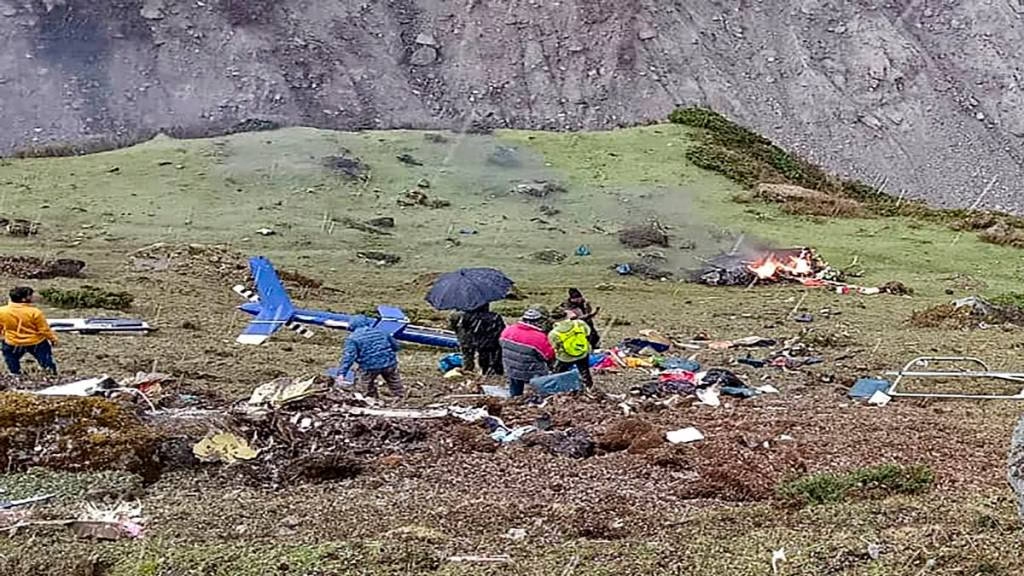Seven Killed in Tragic Helicopter Crash in Uttarakhand’s Kedarghati Region
Aryan Aviation chopper crashes enroute between Gaurikund and Trijuginarayan; authorities initiate high-level investigation into cause amid adverse weather concerns.
Uttarakhand, India — June 15, 2025:
A helicopter operated by Aryan Aviation Pvt Ltd crashed on Sunday in the remote and rugged Kedarghati region of Uttarakhand, claiming the lives of at least seven individuals. The crash, which occurred between Gaurikund and Trijuginarayan — two key locations in the Kedarnath pilgrimage circuit — has cast a pall of grief over one of India’s most revered spiritual regions.
According to initial reports from state authorities and local rescue teams, the helicopter caught fire shortly after crashing in a densely forested area. The aircraft was reportedly enroute to Trijuginarayan, a lesser known but historically significant religious site situated near the Kedarnath route.
All seven individuals onboard, including the pilot and six passengers, are confirmed to have died in the incident. Their identities are currently being verified, and authorities have launched efforts to contact the families.
Scene of the Crash
The crash site lies in a steep and forested stretch of the Himalayan terrain, where air traffic operations are challenging due to unpredictable weather patterns and rugged geography. Gaurikund, the chopper’s departure point, is the last road-accessible stop on the route to the Kedarnath temple, a prominent Hindu pilgrimage destination attracting lakhs of devotees annually.
Eyewitness accounts from nearby villagers and first responders suggest that the aircraft may have encountered sudden visibility issues or a mechanical failure before it plummeted and burst into flames. Emergency personnel reached the site after several hours of trekking due to the inaccessibility of the terrain.
Weather and Terrain Challenges
Weather in Uttarakhand’s higher altitudes can change within minutes, often posing risks to low-altitude aviation. While June is generally part of the pre-monsoon period, the region has experienced sporadic rainfall and fog over the past week.
Aviation experts and meteorological officials have pointed out that such conditions can disorient pilots, especially when navigating narrow valleys like the one in Kedarghati. According to the Indian Meteorological Department, localized fog and low cloud cover were reported in the region around the time of the incident.
Helicopter services in the Kedarnath region are particularly vulnerable during seasonal transitions. In 2022, a similar crash involving another chopper in Uttarakhand killed seven people, prompting regulatory agencies to revise flight operation guidelines for pilgrimage routes.
Regulatory Oversight and Aviation Safety
Aryan Aviation Pvt Ltd is a private operator licensed by the Directorate General of Civil Aviation (DGCA) to conduct non-scheduled air transport services, primarily catering to religious tourism. The company has operated in Uttarakhand for several years, especially during the annual Char Dham Yatra.
The DGCA has ordered an immediate suspension of Aryan Aviation’s services in the region until a preliminary safety audit is completed. A three-member inquiry committee, comprising aviation engineers, flight safety officers, and an official from the Aircraft Accident Investigation Bureau (AAIB), has been constituted to investigate the cause of the crash.
Preliminary findings are expected within a week, although a full investigation could take several months. Meanwhile, all operators conducting flights in the Char Dham region have been instructed to undergo renewed weather briefings and mandatory aircraft inspections before resuming service.
Victims and Rescue Operations
Rescue teams from the State Disaster Response Force (SDRF), the Indo-Tibetan Border Police (ITBP), and local police began recovery operations late Sunday afternoon. As of late evening, all seven bodies had been retrieved and were airlifted to Rudraprayag district hospital for formal identification.
The deceased reportedly include three pilgrims, two crew members including the pilot, and two ground staff who were being transported to assist with pilgrimage operations. Officials have not released the names of the victims pending family notification.
Uttarakhand Chief Minister Pushkar Singh Dhami expressed his condolences, saying, “We are deeply saddened by this tragic incident. All necessary support will be provided to the victims’ families, and a thorough probe will be carried out.”
Impact on Pilgrimage Season
The crash comes during the peak of the Char Dham Yatra season, which sees hundreds of thousands of pilgrim’s travels to Kedarnath, Badrinath, Yamunotri, and Gangotri temples. Helicopter services play a critical role in ferrying elderly and disabled devotees who are unable to make the arduous treks on foot.
With a growing number of private operators entering the pilgrimage aviation sector, questions have often been raised regarding safety regulations, fleet maintenance, and pilot training. Industry observers have repeatedly highlighted the need for stricter oversight and better weather prediction infrastructure in the region.
As a precautionary measure, several helicopter flights to Kedarnath and nearby pilgrimage sites were temporarily suspended following the crash. Authorities are evaluating whether stricter flying conditions should be imposed for the remainder of the season.
Historical Incidents in the Region
This is not the first aviation tragedy in Uttarakhand’s pilgrimage corridor. Over the past decade, the state has seen multiple crashes due to a combination of weather, difficult terrain, and mechanical issues.
In October 2022, a similar crash near Kedarnath involving a helicopter operated by another private company killed all seven onboard.
In June 2013, during the devastating Uttarakhand floods, an Indian Air Force helicopter involved in rescue operations crashed, resulting in the death of 20 military personnel and civilians.
These incidents have led to recurring debates over whether the region’s infrastructure is sufficient to support high-frequency aviation traffic during peak seasons.
Looking Ahead: Calls for Reform
Following Sunday’s tragedy, aviation experts, environmentalists, and religious tourism planners have renewed their calls for:
Real-time weather monitoring systems across pilgrimage routes.
Advanced terrain-aware warning systems in all helicopters operating in the Himalayas.
Mandatory pre-flight simulations and updated training modules for pilots operating in high-altitude zones.
A centralized authority to coordinate and monitor aviation activities in pilgrimage circuits.
Environmentalists have also expressed concern over the increasing pressure on the ecologically fragile Himalayan landscape due to the growing demand for aviation services.
Conclusion
The helicopter crash in Uttarakhand’s Kedarghati region is a stark reminder of the risks involved in operating in some of India’s most challenging terrains. As the region grapples with grief, it also faces tough questions about balancing accessibility, safety, and sustainability in high-altitude religious tourism.
A comprehensive investigation is now underway, and the government is under pressure to not only determine the immediate cause but also implement long-term safety reforms. For the families of those lost and the thousands planning pilgrimages in the months ahead, only time will tell if these lessons are finally taken to heart.
Discover more from The Talkative Indian
Subscribe to get the latest posts sent to your email.















Leave a Reply